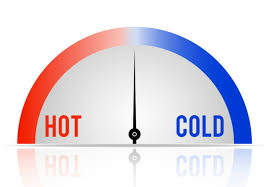Hot or Cold? Which is best for Pain Relief? One of our FAQ!!!
Posted by Phil Heler, MD on September 17, 2018Hot or Cold? How many times are we asked this each month. Here we explain the rationale behind using either hot or cold compresses
Remember PRICE
Ice for new, acute injuries (up to 72 hours) These injuries are usually characterised by a body part that feels hot (usually a joint or muscle) when compared to the uninjured side. It can be swollen, painful and reddened. These are the symptoms of inflammation and ICE is always indicated. The application of ice minimises the extent of damage and inflammation to assist a faster recovery. It is often advised that an acute injury follows the PRICE regime.
Protect: Use aids and appliances to minimise the stresses on the injured area. For example, with an ankle sprain a pair of crutches would be useful or with a shoulder injury a sling will support the injured part.
Rest: Try and avoid provoking the injured area and causing further trauma and inflammation.
Ice: This can be applied in a number of ways from commercial ice packs or more commonly using something like bag of frozen peas. It is important that you avoid ice burn by ensuring there is a barrier between the ice bag and the skin – the usual recommendation is to wrap the ice bag in a wet tea towel. Whilst some debate exists over how long the ice bag should be placed on the injured part and how many times a day, the common advice is often that it should be applied no longer than 15 minutes (less debateable) for 4 times a day (far more debateable!).
Compression: Apply compression at the earliest opportunity following injury to limit and reduce swelling. This is most often the case for a joint sprain or muscle strain. Compression bandages, elasticated tubular bandages or orthopaedic supports are common means of achieving this. Ensure that the compression is even across the injured part, and regularly check the extremities (fingers and toes) for diminished circulation; cold, blue, altered sensation or swollen – these are common signs of too much compression. It is recommended that you remove compression whilst asleep.
Elevation: Try and elevate the injured part at the earliest opportunity. This is to help reduce swelling and is therefore most effective for oedema (swelling) that occurs at the extremities of the body such as an ankle sprain. Heat for chronic injuries (2 weeks) There is much debate about the definition of chronic. Some describe it in terms of time frames, others more in terms of the stage of healing. For the purpose of this information page it doesn’t really matter. A chronic injury is usually characterised by stagnation in terms of healing. The injured part will usually feel the same temperature as the non-injured side, sometimes it may be accompanied by slight swelling if it is a joint of the lower limb. There is a strong sense that the body has finished its healing process but left some residual deficits that continue to cause a problem. This plateau in recovery is most often treated with HEAT. Heat over the injured part will increase the blood flow to it and therefore stimulate activity around this area. If it is a swollen joint this may help reduce any swelling and help flush out any inflammatory agents around the injured site.
The provision of a increased blood supply with greater oxygen and nutrients can help speed up the healing process and decrease pain. If it is an injured muscle, then heat can reduce muscle spasm (or tone) – compare and contrast the difference in muscle tone when we are faced with the cold (shivering) against how our muscles relax in the heat (picture melting away on your sun lounger!). A decrease in muscle spasm will decrease pain and help you to move more normally.
When to use Hot or Cold Compresses
Heat modalities come in many forms. Commonly a clinician may recommend a heat bag that can be placed in a microwave, a hot water bottle, commercial heat packs/pads or hot baths. A comfortable warmth is desirable and usually the application of heat is for a period of 20-30 minutes. Exceptions, debates and personal choice to Ice or Heat Ice treatments might also be used for chronic conditions, such as overuse injuries in athletes – common conditions where this is the case is when a tendon repeatedly becomes inflamed over a long period of time. This can be described as ‘an acute on chronic injury’. In this case your clinician may advise you to apply ice immediately after the activity to minimise the degree of swelling. For an overuse injury the clinician may also recommend heat before the activity to relax and loosen tissues. If there is chronic swelling of a joint such as a long-standing ankle problem, there would be a reasonable argument for a clinician to recommend both heat and ice. We have mentioned that heat increases blood flow (vasodilator) and ice decreases blood flow (vasoconstrictor). With chronic swelling there is a theory that a pumping action can be achieved by placing the heat on the injured area for 5-10minutes and then applying the ice for the same period of time. This cycle is often repeated for up to 30 minutes. When hot and cold water is used to achieve this effect, it is known as a contrast bath.
Where pain is the primary problem with a chronic injury (such as low back pain), the choice of using ice or heat can be a personal preference. On one hand ice has the effect of distracting away from the pain whilst heat can help relax the muscles around the painful area.

